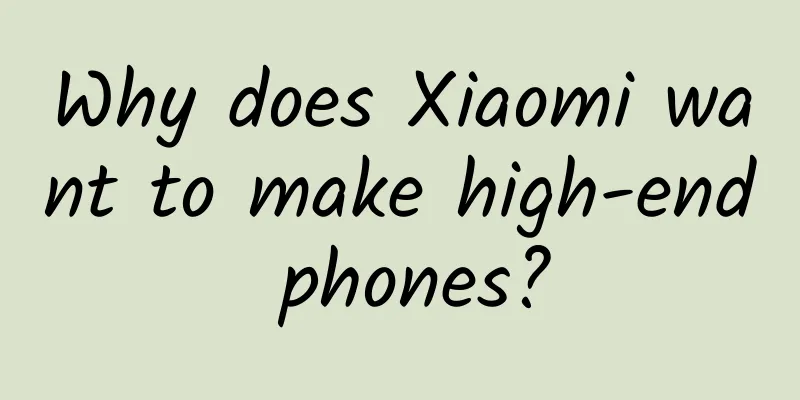Why does Xiaomi want to make high-end phones?

|
At the beginning of the month, Xiaomi held a product appreciation meeting with hundreds of people at the Crowne Plaza Wuzhou near the Bird's Nest. During the more than three-hour appreciation process, I once again felt Lei Jun's excitement, which was a kind of excitement from the heart, an excitement for the official release of the product, and an urgent desire to introduce the advantages of his products to everyone and share good things with everyone. During the whole appreciation process, Lei Jun mentioned the two key words "high cost of accessories and low yield rate" many times, which means that Xiaomi NOTE may not really make money. Think about it, Xiaomi NOTE is the first relatively high-end mobile phone launched by Xiaomi. If this phone has a poor cost performance and no breakthrough in functions, it will be of no value for Xiaomi to enter the high-end market in the future, and it will not be able to form user reputation, and it may even have a counterproductive effect. So why did Xiaomi enter the high-end market? This is a question that is both complex and simple. The complex thing is that few people can explain Xiaomi’s true intention. The simple thing is that it can be made clear in one sentence, which is to make money. In my opinion, Xiaomi's entry into the high-end market is nothing more than the fact that low-end phones are not enough to support Xiaomi's future development. Whether from a macro perspective, Xiaomi gives the capital market room for imagination, or from a micro perspective, Xiaomi is actually facing a decline in demand for low-end phones, or even Xiaomi's future revenue blueprint. Let's first look at the data released by IDC. According to the latest data released by market research firm IDC, smartphone shipments in the first quarter of the Chinese market fell 4.3% year-on-year, which is the first time in six years. Other survey results show that smartphone shipments in the first quarter of the Chinese market are still growing, but the growth rate has slowed down significantly compared with the past. Whether it is a decline or a slowdown in growth, it indicates a reduction in market inventory, and the main reason for the reduction is the decrease in first-time buyers. However, we also see similar views in a data report from Umeng, which shows that the proportion of mobile Internet users changing phones is 56% and 59% respectively, which exceeds the first purchase. In my opinion, low-end smartphones can no longer meet the actual usage needs of most users, especially after users feel the charm of mobile Internet, they will upgrade their phones to meet their usage needs, which is an opportunity for Xiaomi. Secondly, the decline in smartphone shipments is not good for Xiaomi’s capital story. Because the current figures alone cannot support Xiaomi’s valuation of US$46 billion and its internal target of 100 million shipments this year, Xiaomi needs to seek new market opportunities, namely the high-end mobile phone market, and open up global sales channels to maintain and support its valuation, otherwise the myth created by Xiaomi will be shattered. Finally, let's talk about the future revenue direction of Xiaomi. Those who are familiar with Xiaomi know that the way Xiaomi's model is to generate revenue through Internet services in the later stage, and to earn money from users for a lifetime through Internet services, rather than just earning money from hardware processing once. In the future, it is not ruled out that the hardware will be free and only make money through services. Of course, Xiaomi also makes money from hardware, but it is very little, especially after LeEco's disruption, the profit margin has become smaller and smaller. In summary, it is in line with business logic for Xiaomi to make high-end phones, which is within my expectations. In addition, there is also its future internationalization. What is the opportunity cost of the high-end market? Compared with Xiaomi's previous market positioning, at least high-end phones are still a red ocean at present, and a new round of phone replacement will bring certain dividends to this market. This is also the basic guarantee for Xiaomi's decision to enter. The former is an absolute bloody ocean, with not only world-class traditional mobile phone giants, but also powerful new Internet players constantly getting involved, and everyone is using the Xiaomi model to suppress Xiaomi. But in the high-end market, the strongest competitors are nothing more than iPhone and Samsung. I don't think Xiaomi will take other manufacturers seriously. After all, Xiaomi's shipment volume and user scale are there, which other manufacturers can't envy. Just like ZTE, which was released on the same day as Xiaomi and Qihoo, it seems that the market response and attention are average. This may be related to everyone's brand perception of ZTE. Everyone will habitually think that ZTE only has low-end machines and the products are very poor, so many people's first choice of brand is not this. Unfortunately, Samsung, the rival, has run into problems. According to IDC data, Samsung's market share in China has fallen to fourth in the first quarter of this year, compared to first a year ago. This has a lot to do with the rise of Xiaomi. I remember last year Samsung said it was afraid of Xiaomi's rise, but at the time Xiaomi was less than one-third of Samsung's. But now it seems that Samsung's concerns have come true, and even Samsung's high-end phone market may be weakened. However, Samsung is still full of hope for the Chinese market and hopes to continue to win development through its high-end mobile phone product Galaxy S6. Samsung said in a statement, "Although there are signs that the explosive growth of the Chinese smart market will slow down this year, most of the 885 million Chinese mobile phone users are still using low-end and mid-range smartphones. Therefore, even if the Chinese market is saturated, there is still a lot of room for upgrading and replacement of high-end mobile phones." Don't forget that Xiaomi has already started its full-platform strategy. Xiaomi has already started selling Xiaomi NOTE offline at Xiaomi stores, forming an online and offline sales matrix. It should be noted that Xiaomi stores did not sell mobile phones before, but only sold accessories and experiences, as well as repairs. Therefore, Xiaomi stores have also become a social place for mobile phone users. Although there are only 19 Xiaomi Home stores in the country, which are not even covered in the basic central cities and are not enough to threaten Samsung's huge agency channels, no one can guarantee that Xiaomi will not open stores on a large scale in the future, or follow Samsung's offline agency model. At least Xiaomi's products still have certain value in the eyes of scalpers, so the effect of imitating Samsung will not be too bad. Back to how big the opportunities are in the high-end mobile phone market, I think the wave of phone replacement is a relatively big bonus. Xiaomi has a large number of users in the low-end mobile phone (initial) market. Under the Xiaomi ecosystem (especially user data), if Xiaomi launches high-end mobile phones and these users have the need to replace their phones, then the prospects are still very promising. In addition, I am still optimistic about Xiaomi's move as it can plunder market share from other manufacturers. Just as I said at the beginning of the year, if Xiaomi survives this year, the future will be bright. As a winner of Toutiao's Qingyun Plan and Baijiahao's Bai+ Plan, the 2019 Baidu Digital Author of the Year, the Baijiahao's Most Popular Author in the Technology Field, the 2019 Sogou Technology and Culture Author, and the 2021 Baijiahao Quarterly Influential Creator, he has won many awards, including the 2013 Sohu Best Industry Media Person, the 2015 China New Media Entrepreneurship Competition Beijing Third Place, the 2015 Guangmang Experience Award, the 2015 China New Media Entrepreneurship Competition Finals Third Place, and the 2018 Baidu Dynamic Annual Powerful Celebrity. |
<<: Time is running out for Windows Phone to turn around
Recommend
Internet car manufacturing has entered the stage of factory construction and mass production. The wolf is really coming.
The wave of LeEco's car manufacturing has not...
The top ten crisis public relations events that went viral in the first half of 2018. Let’s see who made the list!
That’s right, it’s time for the mid-year review a...
"Moore's Law" is coming to an end. Will photonic chips become the future of the electronics industry?
"The number of transistors integrated into a...
If you think Chongqing is only spicy, then you don’t know it well enough
Text | Wei Shuihua Photo | Visual China When talk...
Zhangping SEO training: What kind of SEO is reliable? Is search engine optimization good?
Although there are many corporate website constru...
I spent two months and failed 6 times in hot spot marketing!
Written to the copywriters and operations people ...
The “knowledge” in “knowledge payment” is as much about “sharing” as the “sharing economy”
1 In “ knowledge payment ”, the “knowledge” compo...
How to use the pyramid model to implement user stratification operations (with case studies)
As the Internet becomes more and more permeable i...
Do you know the eight principles of community operation?
1. Establish a program - the group must have comm...
36 Sales Strategies, Sales Skills That Never Go Out of Style
Mr. Bao once worked for a Fortune 500 company, st...
[Smart Farmers] Debunking rumors: Will eating genetically modified foods change a person’s genes?
[Smart Farmers] Debunking rumors: Will eating gen...
How to make sign-in a powerful tool to increase user activity!
This article will explain which apps are suitable...
Lin Yao | Reaching more possibilities through scientific research
At the beginning of 2023, the Chronic Disease Man...

![RWDS Illustration Course, First Edition, From Beginner to Metamorphosis [High Definition with Materials]](/upload/images/67cc2dc0dbd3a.webp)







